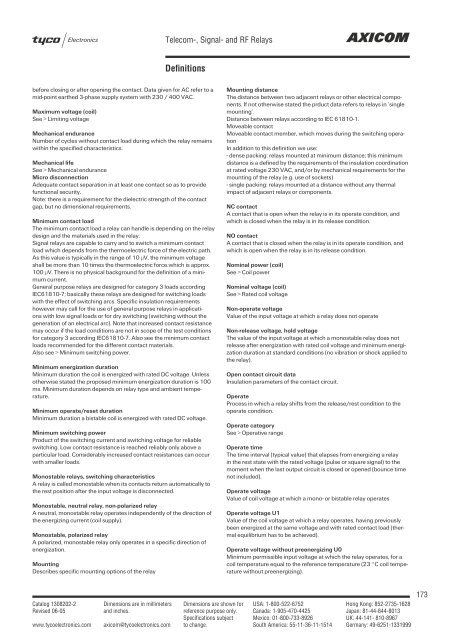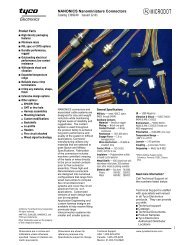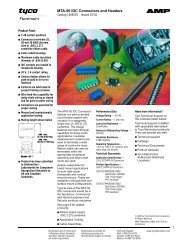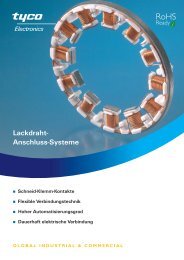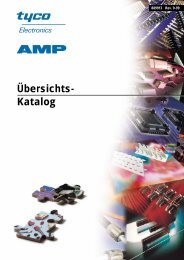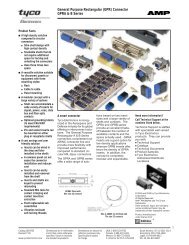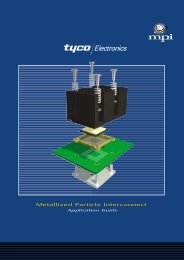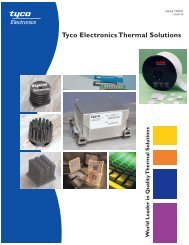IM Relay
IM Relay
IM Relay
Create successful ePaper yourself
Turn your PDF publications into a flip-book with our unique Google optimized e-Paper software.
efore closing or after opening the contact. Data given for AC refer to a<br />
mid-point earthed 3-phase supply system with 230 / 400 VAC.<br />
Maximum voltage (coil)<br />
See > Limiting voltage<br />
Mechanical endurance<br />
Number of cycles without contact load during which the relay remains<br />
within the specified characteristics.<br />
Mechanical life<br />
See > Mechanical endurance<br />
Micro disconnection<br />
Adequate contact separation in at least one contact so as to provide<br />
functional security.<br />
Note: there is a requirement for the dielectric strength of the contact<br />
gap, but no dimensional requirements.<br />
Minimum contact load<br />
The minimum contact load a relay can handle is depending on the relay<br />
design and the materials used in the relay.<br />
Signal relays are capable to carry and to switch a minimum contact<br />
load which depends from the thermoelectric force of the electric path.<br />
As this value is typically in the range of 10 µV, the minimum voltage<br />
shall be more than 10 times the thermoelectric force.which is approx.<br />
100 µV. There is no physical background for the definition of a minimum<br />
current.<br />
General purpose relays are designed for category 3 loads according<br />
IEC61810-7; basically these relays are designed for switching loads<br />
with the effect of switching arcs. Specific insulation requirements<br />
however may call for the use of general purpose relays in applications<br />
with low signal loads or for dry switching (switching without the<br />
generation of an electrical arc). Note that increased contact resistance<br />
may occur if the load conditions are not in scope of the test conditions<br />
for category 3 according IEC61810-7. Also see the minimum contact<br />
loads recommended for the different contact materials.<br />
Also see > Minimum switching power.<br />
Minimum energization duration<br />
Minimum duration the coil is energized with rated DC voltage. Unless<br />
otherwise stated the proposed minimum energization duration is 100<br />
ms. Minimum duration depends on relay type and ambient temperature.<br />
Minimum operate/reset duration<br />
Minimum duration a bistable coil is energized with rated DC voltage.<br />
Minimum switching power<br />
Product of the switching current and switching voltage for reliable<br />
switching. Low contact resistance is reached reliably only above a<br />
particular load. Considerably increased contact resistances can occur<br />
with smaller loads.<br />
Monostable relays, switching characteristics<br />
A relay is called monostable when its contacts return automatically to<br />
the rest position after the input voltage is disconnected.<br />
Monostable, neutral relay, non-polarized relay<br />
A neutral, monostable relay operates independently of the direction of<br />
the energizing current (coil supply).<br />
Monostable, polarized relay<br />
A polarized, monostable relay only operates in a specific direction of<br />
energization.<br />
Mounting<br />
Describes specific mounting options of the relay<br />
Catalog 1308202-2<br />
Revised 06-05<br />
www.tycoelectronics.com<br />
Dimensions are in millimeters<br />
and inches.<br />
axicom@tycoelectronics.com<br />
Telecom-, Signal- and RF <strong>Relay</strong>s<br />
Definitions<br />
Dimensions are shown for<br />
reference purpose only.<br />
Specifications subject<br />
to change.<br />
Mounting distance<br />
The distance between two adjacent relays or other electrical components.<br />
If not otherwise stated the prduct data refers to relays in ‘single<br />
mounting’.<br />
Distance between relays according to IEC 61810-1.<br />
Moveable contact<br />
Moveable contact member, which moves during the switching operation<br />
In addition to this definition we use:<br />
- dense packing: relays mounted at minimum distance; this minimum<br />
distance is a defined by the requirements of the insulation coordination<br />
at rated voltage 230 VAC, and/or by mechanical requirements for the<br />
mounting of the relay (e.g. use of sockets)<br />
- single packing: relays mounted at a distance without any thermal<br />
impact of adjacent relays or components.<br />
NC contact<br />
A contact that is open when the relay is in its operate condition, and<br />
which is closed when the relay is in its release condition.<br />
NO contact<br />
A contact that is closed when the relay is in its operate condition, and<br />
which is open when the relay is in its release condition.<br />
Nominal power (coil)<br />
See > Coil power<br />
Nominal voltage (coil)<br />
See > Rated coil voltage<br />
Non-operate voltage<br />
Value of the input voltage at which a relay does not operate<br />
Non-release voltage, hold voltage<br />
The value of the input voltage at which a monostable relay does not<br />
release after energization with rated coil voltage and minimum energization<br />
duration at standard conditions (no vibration or shock applied to<br />
the relay).<br />
Open contact circuit data<br />
Insulation parameters of the contact circuit.<br />
Operate<br />
Process in which a relay shifts from the release/rest condition to the<br />
operate condition.<br />
Operate category<br />
See > Operative range<br />
Operate time<br />
The time interval (typical value) that elapses from energizing a relay<br />
in the rest state with the rated voltage (pulse or square signal) to the<br />
moment when the last output circuit is closed or opened (bounce time<br />
not included).<br />
Operate voltage<br />
Value of coil voltage at which a mono- or bistable relay operates<br />
Operate voltage U1<br />
Value of the coil voltage at which a relay operates, having previously<br />
been energized at the same voltage and with rated contact load (thermal<br />
equilibrium has to be achieved).<br />
Operate voltage without preenergizing U0<br />
Minimum permissible input voltage at which the relay operates, for a<br />
coil temperature equal to the reference temperature (23 °C coil temperature<br />
without preenergizing).<br />
USA: 1-800-522-6752<br />
Canada: 1-905-470-4425<br />
Mexico: 01-800-733-8926<br />
South America: 55-11-36-11-1514<br />
Hong Kong: 852-2735-1628<br />
Japan: 81-44-844-8013<br />
UK: 44-141- 810-8967<br />
Germany: 49-6251-1331999<br />
173


